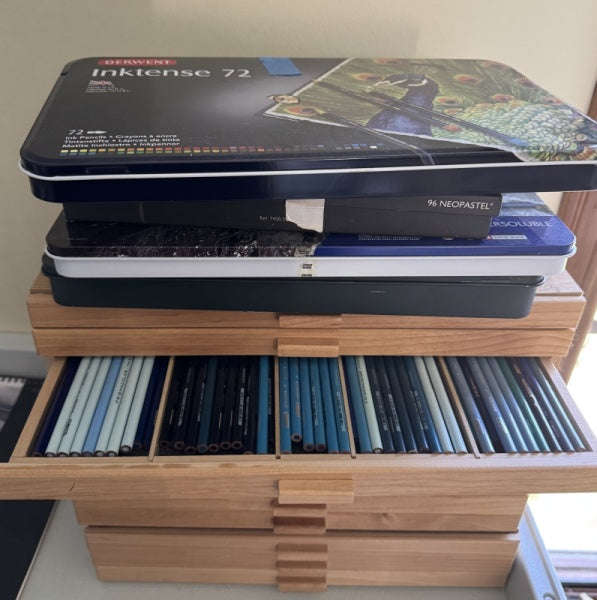Abandoned, not finished...
I heard a wonderful quote at a workshop in SC last year: "A painting is never finished, it's abandoned."
Loved that! I could instantly relate, particularly as a colored pencil artist working in such a painfully slow medium with one of the most painfully slow techniques.
At some point in every portrait, I believe I do just decide to abandon it. Could it be tweaked a little more? Of course. Could I add a little more detail here or there? Yes. If I did, might it be improved? Possibly. Do I care? Ummm...the honest answer by the time I get to that point is "Not enough to keep working on it!"
So it might sound like I'm enouraging abandonment, but I'm really not. I have to admit that I see quite a lot of colored pencil work that in my humble opinion are only about half finished. I understand why so completely, because my own early work was abandoned too soon. It has something to do with courage - and with experience and patience.
 Here is an example of an early work (mid-80's) of mine. (Click on the images to enlarge.) I have not altered the scan in any way, and the scan is very true to the original drawing. It's a self portrait - me as a child in a kimono in Japan in the 50's. At the time I drew this, I thought i'd finished it. Today, I'd consider it half way there! I imagine I thought it was finished because everything I wanted to draw was drawn. Everything had a color. There were some differences in values. What more would I need?
Here is an example of an early work (mid-80's) of mine. (Click on the images to enlarge.) I have not altered the scan in any way, and the scan is very true to the original drawing. It's a self portrait - me as a child in a kimono in Japan in the 50's. At the time I drew this, I thought i'd finished it. Today, I'd consider it half way there! I imagine I thought it was finished because everything I wanted to draw was drawn. Everything had a color. There were some differences in values. What more would I need?
 Let's take a look at it in a gray scale, though. Ooops! I added a little gray scale bar at the bottom so we could easily compare the values in the image with a full range of values. You can see that nothing in the piece gets even close to the end of the gray scale.. Even the darkest values don't quite make it to the middle range of value. It truly is only half finished!
Let's take a look at it in a gray scale, though. Ooops! I added a little gray scale bar at the bottom so we could easily compare the values in the image with a full range of values. You can see that nothing in the piece gets even close to the end of the gray scale.. Even the darkest values don't quite make it to the middle range of value. It truly is only half finished!
 If I were to paint this image today, it would probably end up closer to looking like this versioh. A higher range of values, more color saturation, smoother textures. Yes, it would take me much longer to finish than the original drawing. Yes, it would take more courage to keep pushing the values darker and darker, but the end result would be worth the extra time and effort.
If I were to paint this image today, it would probably end up closer to looking like this versioh. A higher range of values, more color saturation, smoother textures. Yes, it would take me much longer to finish than the original drawing. Yes, it would take more courage to keep pushing the values darker and darker, but the end result would be worth the extra time and effort.
I am guessing that if I knew two things then that i know now, I wouldn't have quit when the piece was half completed.
 Tip #1: Value viewer.
Tip #1: Value viewer.
Simply isolating values makes a world of difference. A hole punched into the middle of a white piece of paper, then placed over your drawing/reference photo will make values become instantly clearer. If I'd known about that handy tool back then, I'm sure I would have kept going on this drawing.
Tips #2: TURN OFF YOUR DRAWING LIGHT!
It might sound nuts, but it's one of the best ways to check your values. Dim the ambient light, turn off your drawing light(s), stand back a few feet from your drawing, with the reference photo close to the drawing. How are you doing? Are you close in value? Or some areas too light? Are ALL areas too light? Maybe you're still just half finished! :-)







Comments (6)
Ann, I believe that quote is from Leonardo da Vinci. Great post!!
Daniela - Dec 27, 2013You know, I took one of your workshops in Florida in 2006. I learned all of this but it is nice to be reminded. I know I don’t go dark enough but fear of ruining my project is always a threat. My New Years resolution will be " Go for it" in all areas of my life. Great post by the way
Stevie - Dec 27, 2013Three years at artschool, a lifetime being a full time artist – and I never knew about the ‘hole punched into a white sheet of paper’ trick. What a good idea. Who’d have thunk it? Thanks Ann.
Julie Podstolski - Dec 27, 2013Wow! This so accurately described me that I could hardly believe it. I love that you showed one of your early works where you “abandoned” too early. It gives me encouragement that I too will “get there”.
Jane Honeycutt - Dec 27, 2013Thanks for this great admission. Coming from someone with your talent, it carries a lot of weight for me. Value is my biggest bugaboo! I do have the white cards with the holes punched – do I use them? Not with any consistency and when I do, I tend to rationalize the obvious away. Duh! As I am beginning my journey into teaching beginning colored pencil next week, this is very timely. What a great message to pass on to people just beginning to express themselves with colored pencil. The lack of a full value scale in a work is so obvious to me – in OTHER people’s work I should say. It is something I will consciously concentrate on now. I like the idea of comparing the work to a gray scale bar. Such an easy way to see truth! Thanks so much for your honesty.
Carol Ballarad - Dec 27, 2013Ann, what a wonderful post and thank you for sharing. I had a friend tell me with one of my pieces I was working on, “do not be afraid of the dark”. So now when I am trying to reach my darkest values I repeat this saying to myself and boy do I end up with wonderful values, especially the dark values. It’s amazing how most of us are afraid of going too dark ;)
Debbie Bowen - Dec 27, 2013